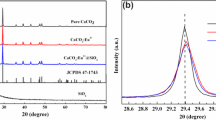Abstract—An yttrium aluminum garnet (YAG) luminescent ceramic activated by Ce3+ has been obtained by uniaxial static pressing followed by sintering in air at a temperature of 1650°C. The initial phosphor powder was characterized and the linear shrinkage dynamics studied. The morphological, elastoplastic, and optical-luminescent properties of the obtained YAG:Ce ceramic samples were studied. The technological mode for manufacturing ceramics of this type with a density of at least 98% and luminescence efficiency of 45% was determined.




Similar content being viewed by others
REFERENCES
D. Chen, W. Xiang, X. Liang, et al., J. Eur. Ceram. Soc. 35, 859 (2015).
D. Chen and Y. Chen, Ceram. Int. 40, 15325 (2014).
S. Agarwal, M. S. Haseman, A. Khamehchi, et al., Opt. Mater. Express 7, 1055 (2017).
N. Wei, L. Tiecheng, L. Feng, et al., Appl. Phys. Lett. 101, 061902 (2016).
D. Haranath, H. Chander, P. Sharma, and S. Singh, Appl. Phys. Lett. 89, 173118 (2006).
M. Raukas, J. Kelso, Y. Zheng, et al., ECS J. Solid State Sci. Technol. 2, 3168 (2013).
E. S. Lukin, Ogneupory Tekh. Keram., No. 9, 13 (1997).
S. F. Wang, J. Zhang, D. W. Lo, et al., Prog. Solid State Chem. 41, 20 (2013).
V. V. Osipov, A. V. Ishchenko, V. A. Shitov, et al., Opt. Mater. 71, 45 (2016).
K. Kamada, T. Yanagida, J. Pejchal, et al., J. Phys. D: Appl. Phys. 44, 1 (2011).
S. Nishiura, S. Tanabe, K. Fujioka, and Y. Fujimoto, Opt. Mater. 33, 688 (2011).
V. V. Osipov, A. V. Ishchenko, V. A. Shitov, et al., Opt. Mater. 71, 98 (2017).
S. Hu, C. Lu, G. Zhou, et al., Ceram. Int. 42, 6935 (2016).
E. H. Penilla, Y. Kodera, and J. E. Garay, Mater. Sci. Eng. B 177, 1172 (2012).
R. Chaim, Mater. Sci. Eng., A 443, 25 (2007).
N. Frage, S. Kalabukhov, N. Sverdlov, et al., J. Eur. Ceram. Soc. 30, 3331 (2010).
M. Sokol, S. Kalabukhov, V. Kasiyan, et al., Opt. Mater. 38, 204 (2014).
H. M. Wang, Z. Y. Huang, J. S. Jiang, et al., Mater. Des. 105, 9 (2016).
D. Lozano-Mandujano, J. Zarate-Medina, R. Morales-Estrella, and J. Munoz-Saldana, Ceram. Int. 39, 3141 (2013).
P. Palmero, B. Boneli, and G. Fantozzi, Mater. Res. Bull. 48, 2589 (2013).
M.-L. Brandily-Anne, J. Lumeau, L. Glebova, et al., J. Non-Cryst. Solids 356, 2337 (2010).
R. Reisfeld, H. Minti, A. Patra, et al., Spectrochim. Acta, Part A 54, 2143 (1998).
A. Sontakke, J. Ueda, Y. Katayama, et al., J. Appl. Phys. 117, 013105 (2015).
K. Zhang, H. Liu, Y. Wu, and W. Hu, J. Alloys Compd. 453, 265 (2008).
Y. Pan, M. Wu, and Q. Su, Mater. Sci. Eng. B 106, 251 (2004).
P. Dorenbos, J. Lumin. 136, 122 (2013).
D. Valiev, T. Han, V. Vaganov, and S. Stepanov, J. Phys. Chem. Solids 116, 1 (2018).
Funding
The study was carried out on the basis of the Nanocenter of Tomsk Polytechnic University with financial support from the Russian Foundation for Basic Research and the administration of Tomsk oblast (project no. 18-43-703014: Characterization of phosphor powder, study of the optical and luminescent properties of ceramic samples), and with partial support from the Russian Science Foundation (project no. 17-13-01233: Ceramic samples, XRD analysis, measurement of mechanical properties) and the state task “Science” (no. 11.7700.2017/BCh: Study of the linear shrinkage dynamics).
Author information
Authors and Affiliations
Corresponding author
Rights and permissions
About this article
Cite this article
Paygin, V.D., Stepanov, S.A., Valiev, D.T. et al. Luminescent Yttrium–Aluminum Garnet Ceramics Obtained by Conventional Sintering on Air. Nanotechnol Russia 14, 113–117 (2019). https://doi.org/10.1134/S1995078019020113
Received:
Revised:
Accepted:
Published:
Issue Date:
DOI: https://doi.org/10.1134/S1995078019020113




